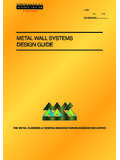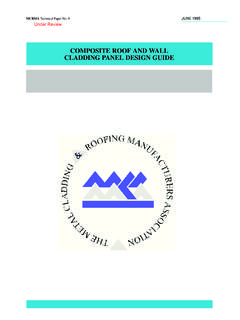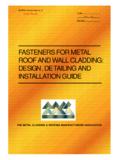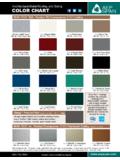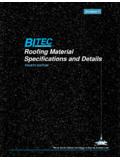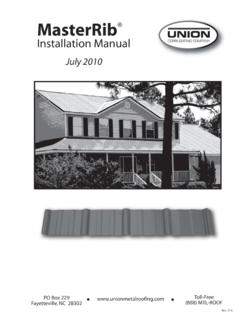Transcription of Guidance For The Design Of Metal Roofing And Cladding To ...
1 Guidance FOR THE Design OFMETAL Roofing AND CLADDINGTO COMPLY WITH APPROVEDDOCUMENT L2 : 2001CI/SfBNh2(23)JANUARY 2002 MCRMA Technical Paper No. 14 PageForeword1 Checklist for compliance with approved document approved document Requirements of the approved Energy efficient Design of the building Maximum areas of windows, doors and Thermal bridging at junctions and around BRE IP 17 Building air Methods for calculating heat loss through plane areas of Cladding and Roofing The development of U-value calculation Computer Thermal Surface condensation and mould Heat loss through thermal Examples of surface temperature and heat loss through thermal Example of the effect of thermal bridging on overall heat Infra-red Thermal Conditions for a Air Whole building testing of air Air leakage Heat loss due to air Laboratory tests for individual
2 Examples of testing carried out at Example of the effect of individual joint leakage on whole Cladding References4141 Contents The Metal Cladding & Roofing Manufacturers Association Limited, January 2002 MCRMA technical papers1. approved document L Conservation of fuel andpower, 1995 edition HMSO approved document L2 Conservation of fuel andpower in buildings other than dwellings. DEFRA/DTLR Report: Limiting thermal bridgingand air leakage: Robust construction details fordwellings and similar buildings. The StationeryOffice, October BS EN ISO 6946 : 1997 Building componentsand building elements Thermal resistance andthermal transmittance Calculation BRE IP 17/01 Assessing the effect of thermalbridging at junctions and around openings BREA ugust CIBSE Guide A3 Thermal properties of buildingstructures CIBSE BS EN 12524 : 2000 Building materials andproducts - Hygrothermal properties -Tabulateddesign BRE Information Paper IP 5/98 : Metal Cladding :assessing thermal performance9.
3 BS EN ISO 10211-1: 1996, Thermal bridges inbuilding construction - Heat flows and surfacetemperatures, Part 1. General calculationmethods10. BS EN ISO 10211-2: 1996, Thermal bridges inbuilding construction - Heat flows and surfacetemperatures, Part 2 Linear thermal BS 5250 :1989 British Standard Code of practicefor control of condensation in BS EN ISO 13788:2001 : Hygrothermalperformance of building components andbuilding elements - Internal surface temperatureto avoid critical surface humidity and interstitialcondensation Calculation methods13. A practical guide to infra-red thermography forbuilding surveys, BRE Report 176, BRE 199114.
4 A professional s guide to testing housing forenergy efficiency, General Information Report64, Energy Efficiency Best Practice Programme, CIBSE Guide TM23:2000, Testing buildings forair leakage, CIBSE BS EN 13829 : 2001 thermal performance ofbuildings Determination of air permeability Fan pressurisation method 17. BS EN 12114:2000 Thermal performance ofbuildings - Air permeability of buildingcomponents and building elements - Laboratorytest 1 Recommended good practice for daylightingin Metal clad buildingsNo 2 Curved sheeting manualNo 3 Secret fix Design guideNo 4 Fire and external steel-clad walls: guidancenotes to the revised Building Regulations1992No 5 Metal wall Cladding Design guideNo 6 Profiled Metal Roofing Design guideNo 7 Fire Design of steel sheet clad external wallsfor building.
5 Construction performancestandards and designNo 8 Acoustic Design guide for Metal roof andwall Cladding No 9 Composite roof and wall Cladding designguideNo 10 Profiled Metal Cladding for roof and walls: Guidance notes on revised BuildingRegulations 1995 parts L & FNo 11 Flashings for Metal roof and wall Cladding : Design , detailing and installation guideNo 12 Fasteners for Metal roof and wall Cladding : Design , detailing and installation guideNo 13 Composite slabs and beams using steeldecking: best practice for Design andconstructionOther publicationsThe Complete Package CDROMM anufacturing tolerances for profiled Metal roof andwall claddingCladSafe latent defects insurance scheme.
6 BasicguideLiabilityWhilst the information contained in this designguide is believed to be correct at the time of goingto press, the Metal Cladding and RoofingManufacturers Association Limited, its membercompanies and the Building ResearchEstablishment cannot be held responsible for anyerrors or inaccuracies and, in particular, thespecification for any application must checked withthe individual manufacturer concerned for a diagrams of typical constructions in thispublication are illustrative publication has been produced by the MetalCladding and Roofing Manufacturers Association(MCRMA) in collaboration with BRE, to assist thedesigners, manufacturers and installers of metalwalls and roofs to comply with the requirements ofApproved document L2 of the BuildingRegulations, published in October 2001 to comeinto force in April describes the content of those parts of theApproved document relevant to Metal claddingand Roofing systems and gives Guidance as to: The calculation of U-values Allowing for thermal bridging at junctions andopenings Infra-red surveys Air leakage testingThe Guidance is designed to be relevant to bothtwin skin and composite panel of U-values1.
7 approved document L2 requires that the U-values of Metal site assembled and compositepanel walls and roofs must be less than or equalto W/m2K and W/m2K respectively.(The corresponding values in Scottish TechnicalStandard J are W/m2K and W/m2K).These values include associated componentssuch as gutters and smoke vents however,rooflights, windows and doors have Because the method for calculating U-valuescontained in BS EN ISO 6496 and CIBSE GuideA does not apply to Metal Roofing and claddingsystems, more complex methods must be If the construction is one of those covered inBRE IP 5/98, the U-value can be obtained fromthe graphs or other information in the IP andcorrected for air spaces and compression of theinsulation by the profiles using the equations inthe If the component contains independent linearfeatures that can be represented by a series oftwo-dimensional models, use a two-dimensionalmodel and combine the results from the If the component contains repeating pointthermal bridges, such as clips, develop a three-dimensional model to calculate the heat flowsand then the bridging1.
8 approved document L2 requires that thebuilding fabric should be constructed so thatthere are no significant thermal bridges or gapsin the insulation layer(s) within the variouselements of the fabric, at the joints betweenelements and at the edges of elements such asthose around window and door openings. It isalso necessary to account for penetration of theinsulated envelope by features such as safetyharness posts or rafters which project to supporta canopy or for compliancewith approved document L2 Summary of window and door lintels, jambsand sillsGap between window or doorfmin= and Cladding as Figs = W/mKand moved forward in line withfmin= liner = W/mKInsulation included betweenfmin= or door frame and = W/mKstructural steel and Cladding , asFig to , but not with insulation includedfmin= window or door frame = W/mKand structural steel and Cladding ,but sill flashing crossing theinsulation.
9 As Fig Thermal BridgesSome features of industrial buildings in which steelelements penetrate the insulation, exist at onlydiscrete points, and are not linear features like theother details discussed in this Appendix. Althoughtheir analysis is not a requirement of ApprovedDocument L, it should be recognised that they canbe sources of extra heat loss from the building and,more importantly, can locally lower the internalsurface temperature low enough to cause severesurface condensation, especially in high humiditybuildings. These features are much more variablethan the other details discussed above and theexamples below are included for illustration calculations should be done wheneverany of these features are included in a highhumidity building.
10 Two examples are shown in thefigures below:a) a harness attachment post, which is a hollowsteel post, with 2mm thick walls, which isattached to the structural steel inside thebuilding and passes through the roof;b) a girder, which is attached to the structuralsteelwork within the building and passes thoughthe insulated Cladding to support, for example acanopy or eaves each example, the value of fminand the extraheat loss in W/K, caused by each is quoted; thetotal heat loss is found by multiplying this by thenumber of these features in the : Harness attachment postFig : Internal surface temperaturefmin= , Heat loss = W/KFig : Canopy girderFig : Internal surface temperaturefmin= , Heat loss = W/K2.



